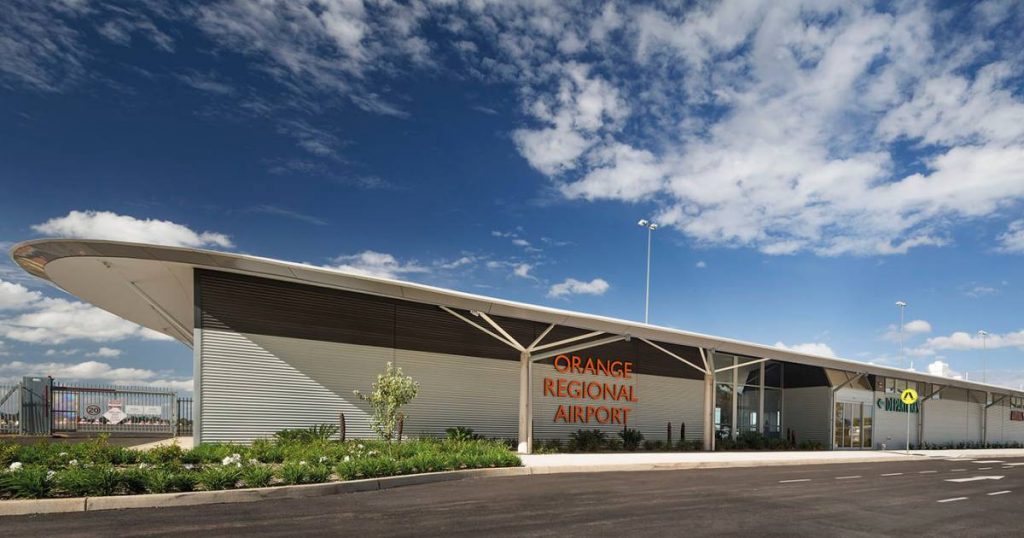
Image via Cox Architecture (a company involved with 2012-2015 airport expansion)
Orange Regional Airport’s new solar power system won’t be a particularly big ‘un, but every panel and every clean kilowatt-hour counts.
On Wednesday, the NSW Government announced it would kick in $1.5 million towards a $2 million upgrade at the airport. Among the improvements will be a rooftop solar power system, which Orange City Council says will be one of Council’s biggest solar arrays.
So how big will it be? A total capacity figure wasn’t provided, but Council says 200 solar panels will be installed. If 340 watt panels are used, which I’m told is a common capacity for new commercial solar installations in Australia currently, that would work out to 68 kilowatts capacity. A system of that size could generate an estimated 107 megawatt-hours of electricity a year.
There will also be new facilities to make use of some of the clean energy goodness the system cranks out; including workstations for business travellers, charging points, wi-fi, technology upgrades for the conference room and a large digital display screen. A new secure parking area and shelter over the airport entrance also feature among the upgrades.
“The Orange airport is a crucial gateway to business and recreational travellers who come to the region,” Mayor Reg Kidd said. “I’m delighted the council can work in partnership with the NSW Government to deliver this upgrade.”
The airport is owned, operated and maintained by Council and is situated 15 kilometres south east of Orange. The facility has been getting busier in recent years, with annual passenger numbers for 2017/18 reaching 70,412; compared to 56,948 in 2016/17.
Among Council’s other PV installations is a 100kW system that was installed at the Aquatic Centre back in 2017, and a 35-kilowatt system at the Works Depot operating under a power purchase agreement (PPA) arrangement.
In addition to taking saving on electricity costs seriously, Council’s role in addressing the issue of climate change hasn’t gone ignored; with it also part of the Climate Council’s Cities Power Partnership.
As for solar energy elsewhere in the Orange City Council area, the Australia Photovoltaic Institute indicates approximately 14.9% of dwellings had panels installed as at January this year (est. dwellings: 17050, installations: 2748). Commercial solar appears to be pretty popular, with an estimated 207 installations at that point between 10kW and 100kW capacity.

 RSS - Posts
RSS - Posts



What a contrast!
A strapped for cash major regional council in Australia ignores the naysayers and installs solar PV systems to reduce its ongoing costs for the next 20 to 30 years or so.
In contrast, Brazil’s biggest mining company, Vale; today warned residents in a town some 60 kms away from one of their mines, that a dam collapse could occur within the next week, causing a huge toxic mudslide that would virtually destroy the town.
The same company was responsible for Brazil’s worst ever environmental disaster back in 2015, when a dam at another of their huge mines collapsed.
.
In the Northern hemisphere, Norway, with its relatively tiny population of 580.000, and where its somewhat dark for 6 months of the year, is happily exporting electricity generated from vertically mounted solar PV panels to nearby heavily polluted European countries, and presumably making money by doing so. (don’t believe everything that coal clutching Australian Ministers for Energy tell you about Norway – fact check it yourself).
Here’s the link to the BBC News article about Brazil;
https://www.bbc.com/news/world-latin-america-48391767
Given the current growth rate in solar PV installations in NZ, (both large scale commercial and residential) it seems quite possible to me that some enterprising Kiwi business will work out some neat way of ‘exporting’ their surplus PV generation to Australia and various places in the South Pacific region the not too distant future.